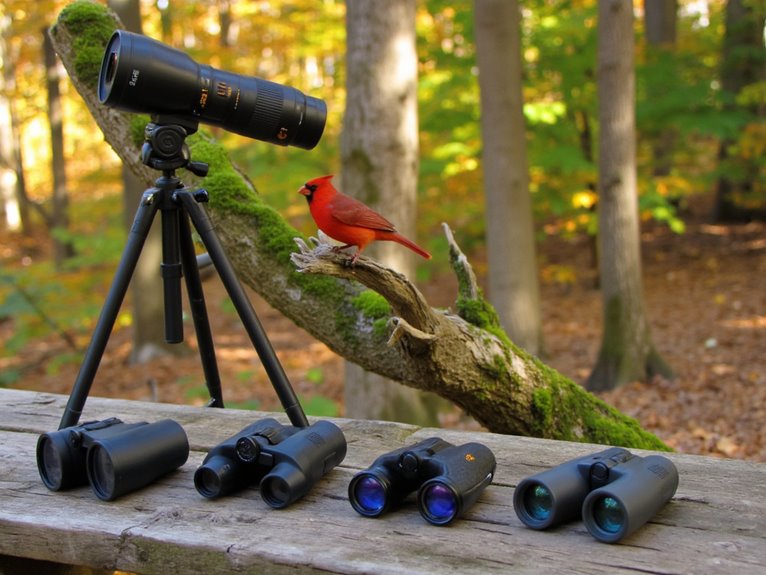10 Best Magnifications for Bird Watching: Expert-Recommended Power Levels
For ideal bird watching, I recommend 8x to 12x magnification as the sweet spot. 8×42 models provide the widest field of view for tracking fast-moving songbirds in dense foliage, while 10x magnification offers the best balance of stability and detail for general birding. 12×50 monoculars excel for distant raptors and waterfowl identification. Avoid extreme magnifications like 80x, which sacrifice field of view and stability. The following comparison reveals specific applications for each power level.
We are supported by our audience. When you purchase through links on our site, we may earn an affiliate commission, at no extra cost for you. Learn more. Last update on 18th July 2025 / Images from Amazon Product Advertising API.
Notable Insights
- 8x-10x magnification offers the best balance of stability, field of view, and image brightness for most bird watching situations.
- 12x magnification provides excellent detail for distant birds but requires steadier hands and may sacrifice some image clarity.
- 16x magnification delivers professional-grade viewing power but works best with tripod support to minimize hand shake.
- Magnifications above 20x offer extreme detail but significantly narrow the field of view, making bird tracking challenging.
- Lower magnifications (6x-8x) excel in dense habitats where wide field of view is crucial for spotting moving birds.
Explorer High Powered 12X50 Monocular for Bird Watching and Wildlife
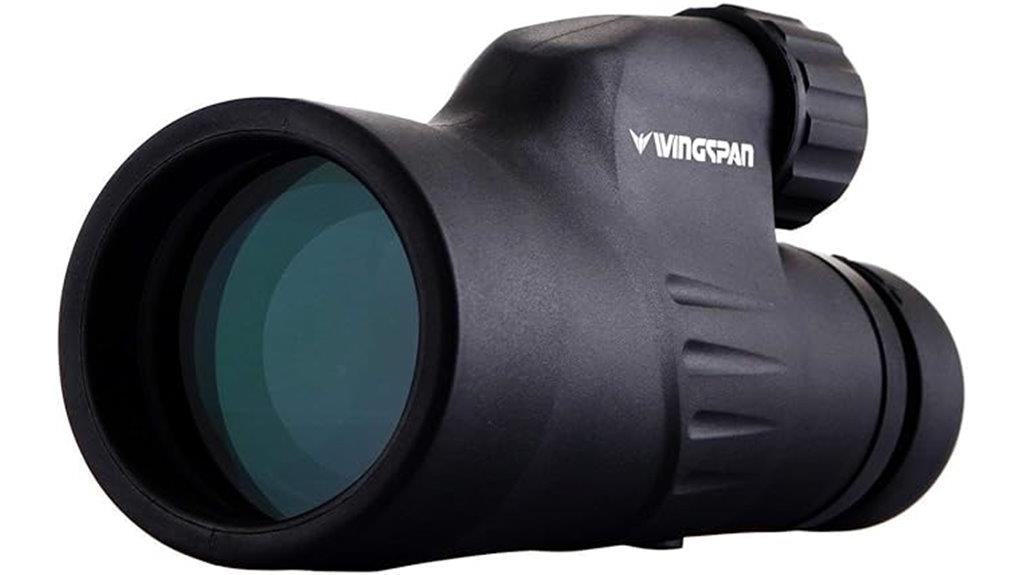
The Explorer High Powered 12X50 Monocular delivers 12X magnification with a 50mm objective lens, making it an ideal choice for bird watchers who need powerful zoom capabilities in a compact, single-handed device. Weighing just 11 ounces and measuring 9.4 x 7.9 x 4.1 inches, you’ll find it fits comfortably in jacket pockets. The ergonomic design lets you focus quickly with one hand using your thumb on the focus ring. You’ll appreciate its waterproof and fog-proof construction that prevents moisture infiltration during field use. The 50mm lens gathers sufficient light for low-light conditions, though optical crispness diminishes at maximum zoom compared to premium brands.
Best For: Bird watchers and casual wildlife observers who need a lightweight, portable monocular with powerful 12X magnification that can be operated easily with one hand.
Pros:
- Lightweight at 11 ounces with compact design that fits in jacket pockets for easy portability
- Waterproof and fog-proof construction with durable external armor for reliable field use
- Single-hand operation with ergonomic focus ring design allows quick focusing while maintaining observation
Cons:
- Optical crispness diminishes at maximum zoom and doesn’t match high-end brands like Swarovski
- Belt strap may need replacement or reinforcement due to durability concerns
- Field of view becomes more limited at 12X magnification compared to lower power optics
STScope360 Monocular Telescope for Bird Watching with Adapter & Tripod
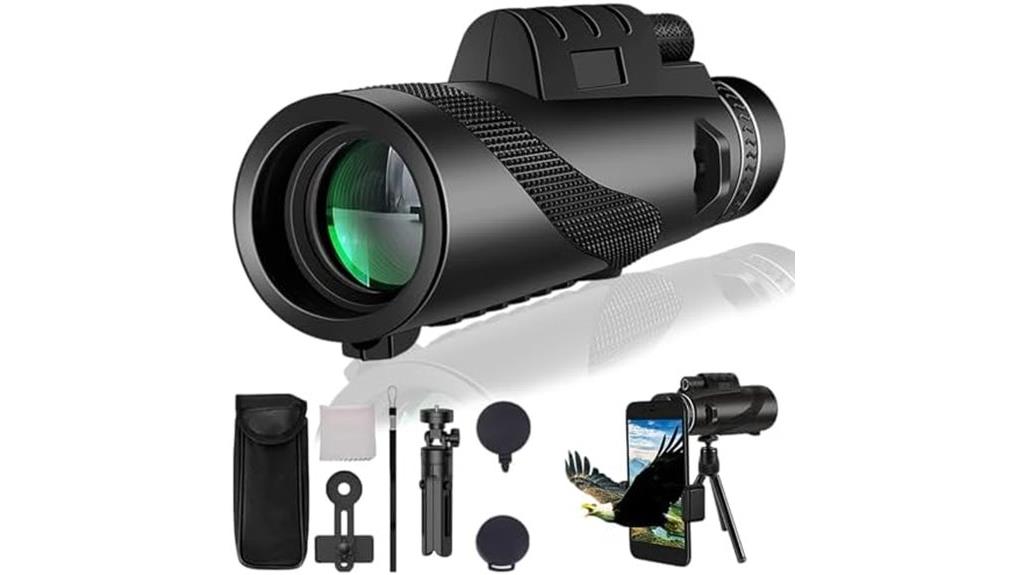
Wildlife photographers and birding enthusiasts who demand versatility will find the STScope360 Monocular Telescope exceptionally well-suited for their needs, since it combines 10X magnification with smartphone connectivity features. The 36mm objective lens delivers bright, detailed images through military-grade BAK-4 prisms and fully multi-coated lenses. You’ll capture clear views even in low-light conditions without black edges affecting image quality.
The waterproof and fog-proof construction guarantees reliable performance in harsh outdoor environments. You’ll receive a phone mount and tripod that enable high-definition image capture and sharing. This monocular functions effectively for hiking, concerts, sports events, and wildlife observation, providing stable panoramic views across multiple scenarios.
Best For: Wildlife photographers, birding enthusiasts, and outdoor adventurers who need a versatile monocular telescope with smartphone connectivity for capturing and sharing high-quality images across various activities.
Pros:
- 10X magnification with 36mm objective lens and military-grade BAK-4 prisms deliver bright, detailed images even in low-light conditions
- Waterproof and fog-proof construction ensures reliable performance in harsh outdoor environments
- Includes phone mount and tripod for easy smartphone connectivity, image capture, and stable viewing
Cons:
- Single 10X magnification option may limit flexibility for users who need variable zoom capabilities
- Monocular design provides less depth perception compared to binoculars for extended viewing sessions
- Smartphone mount compatibility may vary depending on phone size and case thickness
80×100 Monocular Telescope for Smartphone – High Definition for Stargazing & Wildlife

Serious birdwatchers who demand extreme magnification capabilities will find the 80×100 monocular telescope delivers unmatched performance for distant wildlife observation. The 80x magnification combines with a 100mm aperture to produce exceptional image brightness and clarity. You’ll capture detailed views of birds at distances impossible with standard binoculars.
The lightweight, compact design enables comfortable one-handed operation during extended viewing sessions. You can quickly attach your smartphone using the included positioning bracket and tripod for high-definition image capture. The rugged, water-resistant body withstands harsh outdoor conditions while hiking or camping. This monocular excels across multiple applications beyond birdwatching, including stargazing and general wildlife observation, making it valuable for serious nature enthusiasts.
Best For: Serious birdwatchers, nature enthusiasts, and outdoor adventurers who need extreme magnification capabilities for detailed wildlife observation and stargazing at long distances.
Pros:
- Exceptional 80x magnification with 100mm aperture provides superior image brightness and clarity for distant object observation
- Includes smartphone bracket and tripod for high-definition image capture and easy sharing of observations
- Rugged, water-resistant construction withstands harsh outdoor conditions while remaining lightweight and compact for one-handed operation
Cons:
- Extremely high magnification may cause image shake and difficulty maintaining steady viewing without a tripod
- Single eyepiece design lacks the depth perception and comfort that binoculars provide during extended viewing sessions
- High magnification significantly reduces field of view, making it challenging to locate and track moving wildlife
16X52 Monocular Telescope High Powered for Adults

Bird watchers seeking exceptional magnification power will find the 16X52 Monocular Telescope delivers professional-grade optics in a remarkably compact package. The 16x magnification paired with a 52mm objective lens captures detailed images at impressive distances. You’ll appreciate the BAK4 prism system and fully multi-coated lenses that enhance brightness and clarity. The unit weighs just 0.35 ounces and measures 2.55 x 2.55 x 6.6 inches, making it extremely portable. You can operate it with one hand while adjusting the eyecup and focus wheel. The waterproof, fog-proof construction uses high-purity nitrogen filling for harsh weather conditions. Customers rate it 4.3 stars across 4,026 reviews.
Best For: Bird watchers, hikers, and outdoor enthusiasts who need a lightweight, portable monocular with strong magnification for distance viewing and wildlife observation.
Pros:
- Exceptional portability at just 0.35 ounces with professional 16x magnification and 52mm objective lens for detailed long-distance viewing
- Waterproof and fog-proof construction with high-purity nitrogen filling makes it reliable in harsh weather conditions
- Easy one-handed operation with adjustable eyecup and focus wheel, plus BAK4 prism system for enhanced brightness and image quality
Cons:
- Some users report the effective range is closer to 1000m rather than the advertised 2000m maximum distance
- Mixed feedback indicates difficulty with focus adjustments, particularly for users with vision concerns
- Single-eye viewing may cause fatigue during extended use compared to binoculars
Monocular-Telescope 80×100 High Powered with Smartphone Adapter
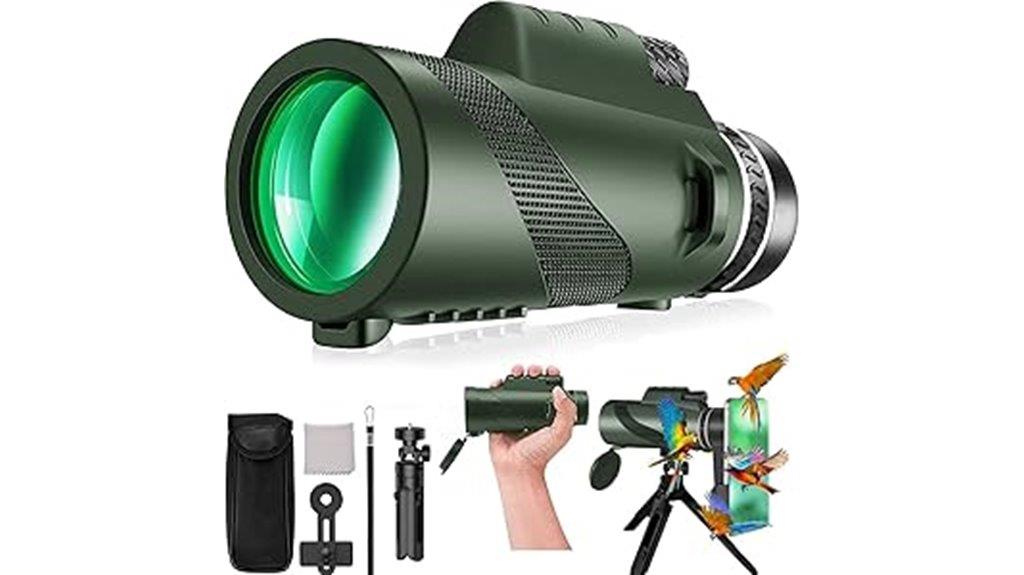
The PhysioPhyx Monocular-Telescope 80×100 delivers exceptional versatility for birders who demand smartphone photography capabilities alongside traditional observation. You’ll appreciate the BAK-4 prism optical structure and fully multi-coated lenses that enhance light transmission and image clarity. The 100mm objective diameter maximizes light gathering for detailed bird identification.
However, you should note customer reports indicating actual magnification performs closer to 5-10x rather than the advertised 80x specification. The included tripod provides essential stability for extended viewing sessions. You’ll find the smartphone adapter particularly useful for capturing and sharing bird sightings. The adjustable eyecups accommodate glasses wearers comfortably. At 1.04 pounds, this monocular remains manageable during lengthy field excursions.
Best For: Birders and outdoor enthusiasts who want smartphone photography capabilities and stable viewing with quality optics, but don’t require true high-magnification performance.
Pros:
- BAK-4 prism optical structure with fully multi-coated lenses provides excellent light transmission and image clarity
- Includes both sturdy tripod for stability and smartphone adapter for capturing and sharing observations
- Lightweight at 1.04 pounds with adjustable eyecups that accommodate glasses wearers comfortably
Cons:
- Actual magnification performs at only 5-10x despite advertised 80x specification
- Limited customer feedback with only 7 ratings and moderate 3.3-star rating
- May not provide sufficient magnification for serious birders requiring detailed long-distance observation
10×42 High-Powered Monocular for Adults with Tripod

Wildlife enthusiasts who demand superior optical performance in challenging field conditions will find the 10×42 high-powered monocular delivers exceptional clarity and versatility. The 42mm objective lens captures maximum light while maintaining portability at just 0.5 pounds. You’ll appreciate the BAK4 prism system and fully multi-coated lenses that enhance dawn and dusk viewing sessions when birds are most active. Military-grade construction includes shockproof rubber armor and IPX7 waterproofing for reliable field use. The included smartphone adapter lets you document rare sightings, while the mini tripod provides steady observation during extended birding sessions without hand fatigue.
Best For: Wildlife enthusiasts, bird watchers, and outdoor adventurers who need a portable, high-performance monocular with superior low-light capabilities for field observation and documentation.
Pros:
- Exceptional optical performance with 10x magnification, 42mm objective lens, BAK4 prism, and fully multi-coated lenses for bright, clear images even in low-light conditions
- Rugged military-grade construction with shockproof rubber armor and IPX7 waterproofing ensures reliable performance in harsh outdoor environments
- Complete package includes smartphone adapter for photo/video capture and mini tripod for stable, hands-free viewing during extended observation sessions
Cons:
- Single-eye viewing may cause eye strain during prolonged use compared to binoculars
- 10x magnification can be challenging to steady without the tripod, especially for handheld use
- Monocular design provides no depth perception, which may be limiting for certain outdoor activities
POLDR 12X25 Small Pocket Binoculars for Adults and Kids

Compact design makes the POLDR 12X25 Small Pocket Binoculars an ideal entry-level choice for budget-conscious birders who prioritize portability over premium optics. You’ll appreciate the 3.7 x 2.2 x 0.04-inch dimensions and 5.8-ounce weight that fits comfortably in your pocket. The 12X magnification paired with 25mm objective lenses delivers a 126-foot field of view at 1000 yards. BAK4 prisms provide adequate light transmission, though you’ll notice limited edge clarity and reduced low-light performance compared to premium models. The smooth center-focus mechanism includes right-eye adjustment for precise targeting. While these binoculars won’t match high-end optics, they’re perfectly suitable for casual birding adventures.
Best For: Budget-conscious birders, casual outdoor enthusiasts, and beginners who prioritize portability and affordability over premium optical performance.
Pros:
- Ultra-compact and lightweight design at just 5.8 ounces makes them ideal for pocket carrying during hiking and outdoor activities
- Affordable entry-level price point perfect for beginners or those concerned about potential loss or damage
- Smooth center-focus mechanism with right-eye adjustment provides easy and precise focusing
Cons:
- Limited edge clarity and collimation quality issues affect overall image sharpness
- Poor low-light performance despite BAK4 prisms, with noticeable darkness in nighttime viewing
- Quality control inconsistencies reported by users, with variable performance across units
GORILLA GRIP 10×25 Compact Binoculars for Adults with Strap
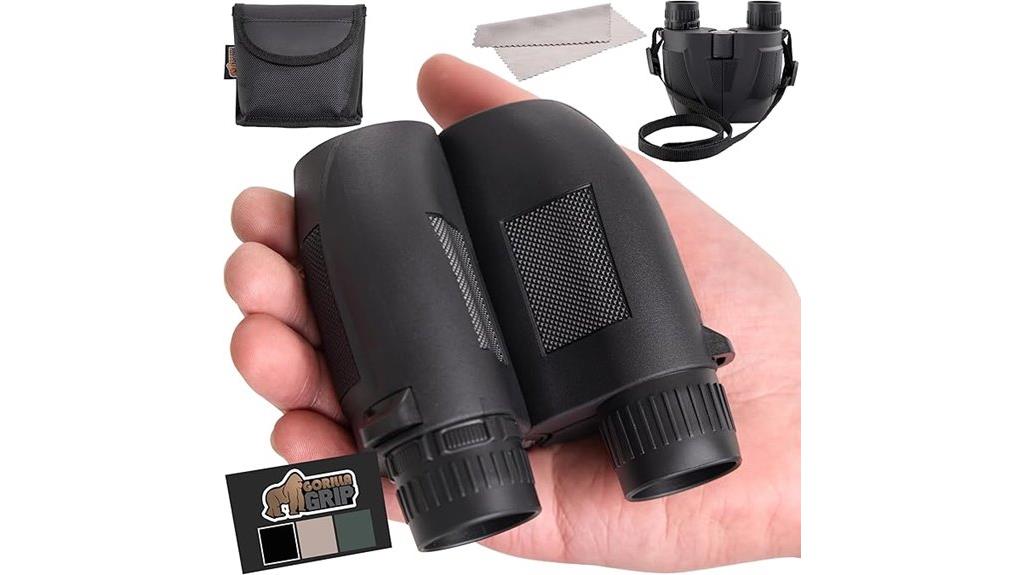
Bird watchers who prioritize portability without sacrificing magnification power will find exceptional value in the GORILLA GRIP 10×25 Compact Binoculars. These optics deliver 10X magnification with clear viewing up to 1,000 yards through fully multi-coated lenses and BAK4 prism glass. At just 0.73 pounds and measuring 4 x 4.17 x 3.74 inches, they’ll easily slip into your backpack or jacket pocket. The textured grip guarantees secure handling during extended observations, while shock-resistant construction protects against accidental drops. Weather-resistant design withstands outdoor conditions, though they’re not submersion-rated. You’ll appreciate the adjustable PVC eye cups that accommodate eyeglass wearers, plus included accessories like cleaning cloth and carrying case.
Best For: Bird watchers, hikers, and outdoor enthusiasts who need portable binoculars with strong magnification power for activities like wildlife observation, sporting events, and travel.
Pros:
- Excellent portability at just 0.73 pounds with 10X magnification power for detailed viewing up to 1,000 yards
- Superior optical clarity through fully multi-coated lenses and BAK4 prism glass with anti-reflective coating
- Durable construction with textured grip, shock resistance, and weather-resistant design plus complete accessory package
Cons:
- Limited eye relief may not be ideal for eyeglass wearers despite adjustable PVC eye cups
- Not waterproof or submersion-rated, only weather-resistant for light moisture exposure
- Some users report minor edge blurring which is typical for binoculars in this price range
12×50 High-Power Monocular Telescope with Smartphone Tripod

Advanced birders seeking professional-grade magnification will find exceptional value in the 12×50 High-Power Monocular Telescope, which delivers 12x magnification through a 53mm objective lens for detailed wildlife observation at distances up to 325 feet. The BAK4 prism and Fully Multi-Coating technology guarantee bright, color-accurate images with enhanced light transmission. You’ll appreciate the 6.5° wide field of view and 20mm eyepiece for comfortable extended viewing sessions.
The unit’s compact 5x2x3-inch design weighs just 13.4 ounces, making it highly portable for field work. The included smartphone tripod with adjustable angles and lengths enables stable viewing and photo documentation. Compatible with major smartphone brands, this monocular ranks #2 in its category for proven performance in professional birding applications.
Best For: Advanced birders and outdoor enthusiasts who need professional-grade magnification and smartphone compatibility for detailed wildlife observation and photo documentation.
Pros:
- High-quality optics with BAK4 prism and Fully Multi-Coating technology deliver bright, color-accurate images
- Includes smartphone holder and adjustable tripod for stable viewing and photo capabilities
- Compact and lightweight design (13.4 oz) makes it highly portable for field use
Cons:
- Limited range visibility of only 325 feet may not be sufficient for long-distance wildlife observation
- Single eyepiece design provides less depth perception compared to binoculars
- Higher magnification (12x) can make it more difficult to maintain steady hand-held viewing
National Geographic 8×42 Binoculars for Adults
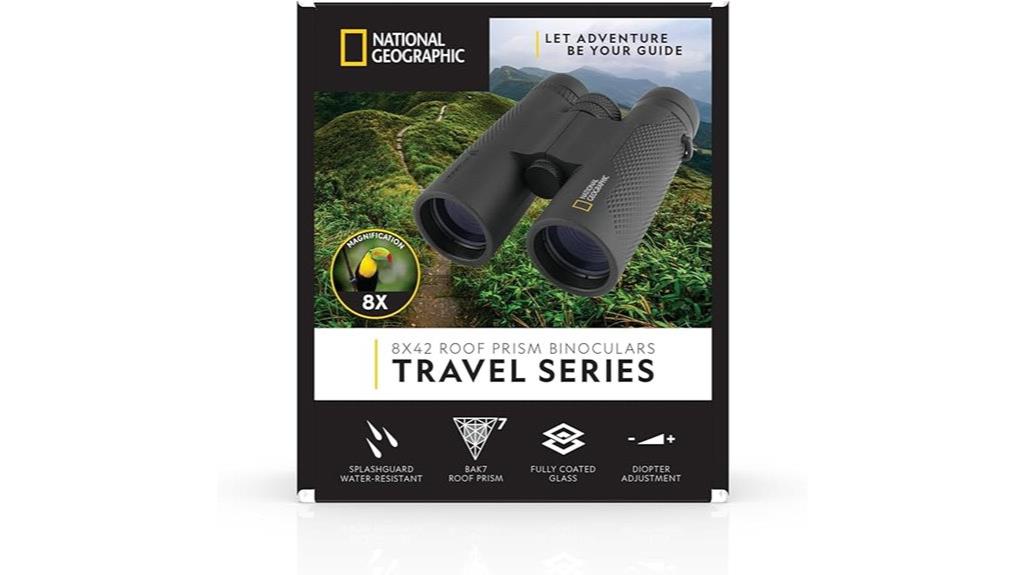
When you need dependable optics that balance performance with portability, the National Geographic 8×42 Binoculars for Adults deliver exceptional value for recreational birders and outdoor enthusiasts. The 8x magnification provides a superior field of view for tracking active birds without sacrificing image stability. You’ll appreciate the 42mm objective lenses that gather sufficient light for clear viewing during dawn and dusk birding sessions.
The fully coated optics enhance light transmission and contrast remarkably. Twist-up eyecups accommodate eyeglass wearers comfortably, while diopter adjustment reduces eye strain during extended observations. Water-resistant construction withstands field conditions dependably. The lightweight roof prism design won’t burden you during long hikes, and textured gripping surfaces guarantee secure handling.
Best For: Recreational birders and outdoor enthusiasts who need portable, dependable optics for activities like birdwatching, hiking, and travel without requiring professional-grade performance.
Pros:
- 8x magnification with 42mm lenses provides excellent field of view and light gathering for dawn/dusk viewing
- Lightweight roof prism design with water-resistant construction ideal for extended outdoor use
- Twist-up eyecups and diopter adjustment accommodate eyeglass wearers and reduce eye strain
Cons:
- Mixed user reviews indicate inconsistent optical clarity quality across units
- Basic fully coated optics may not match premium multi-coated alternatives for image sharpness
- Mid-range market ranking suggests limited standout features compared to competitors
Factors to Consider When Choosing Magnification for Bird Watching
When I’m selecting magnification for bird watching, I must balance five essential factors that directly impact my viewing experience and success in the field. Field of view determines how much area I can scan at once, while hand stability requirements increase markedly with higher magnifications above 8x. Light gathering ability, target bird distance, and equipment weight all influence whether I’ll achieve sharp, bright images or struggle with shaky, dim views during vital observation moments.
Field of View
Field of view determines how much area you can observe through your binoculars at any given moment, measured as the width in feet visible at 1,000 yards distance. I recommend prioritizing wider FOV for bird watching since it helps you track moving targets without constant repositioning.
Magnification directly affects FOV. A 10x magnification typically provides a broader viewing area than 12x models, making it easier to spot and follow birds in flight or perched in dense treetops. Higher magnification narrows your observable area, which can make locating fast-moving subjects challenging.
Objective lens diameter also influences FOV alongside magnification. Adequate field of view proves essential for landscape observation, enabling you to find and identify birds more efficiently in their natural habitats rather than struggling with tunnel vision.
Hand Stability Requirements
Magnification power directly impacts your ability to maintain a steady view, and this stability factor often determines the practical usability of your binoculars in the field. At 8x magnification, minor hand movements remain manageable for most users. However, 12x and 16x magnifications amplify every tremor considerably.
I recommend using tripod support for any magnification above 10x. The increased shake at higher powers makes handheld observation frustrating and counterproductive. Your viewing experience deteriorates rapidly when image stability suffers.
Choose lightweight monoculars to reduce arm fatigue during extended sessions. Ergonomic grips and smooth focusing mechanisms provide better control at higher magnifications. These features become essential when you’re tracking fast-moving birds through dense foliage where precise adjustments matter most.
Light Gathering Ability
Light gathering capability becomes the critical performance factor that separates exceptional bird watching optics from mediocre ones. The objective lens diameter directly determines how much light your monocular captures. A 50mm lens delivers superior light transmission compared to smaller apertures, making it ideal for dawn and dusk observations when birds are most active.
I recommend balancing magnification with lens size for peak performance. Higher magnification without adequate lens diameter creates darker images due to reduced light capture. The 12×50 configuration provides excellent light visibility across varying conditions.
Fully multi-coated optics enhance this capability by minimizing light reflection and reducing loss. These coatings considerably brighten images while maximizing light gathering efficiency. For serious birders, prioritizing larger objective lenses guarantees clear, bright viewing regardless of lighting conditions.
Target Bird Distance
Distance to your target determines which magnification will deliver best results for bird identification. For birds within 100 yards, I recommend 8x to 10x magnification. This range provides ideal detail while maintaining a wide field of view for tracking movement.
When observing birds beyond 300 yards, you’ll need 12x magnification or higher. Higher powers reveal fine details on distant species but create trade-offs. The field of view narrows markedly, making it harder to follow active birds.
Environmental conditions affect your choice. Wind and vibration become problematic with magnifications above 15x. You’ll need a tripod or stabilizing device to maintain clear images. Consider your typical viewing distances carefully. Choose magnification that matches where you’ll encounter most birds during your outings.
Equipment Weight Balance
Weight distribution affects your viewing comfort more than total magnification power alone. I recommend choosing binoculars weighing 10 to 13 ounces for ideal portability and performance balance. Heavier models cause arm fatigue during extended sessions, reducing your ability to maintain steady aim on fast-moving birds.
Well-balanced designs distribute weight evenly between the lens and body. This configuration minimizes strain on your arms and enhances stability while tracking birds. Compact models under 13 ounces offer superior one-handed operation, allowing quick adjustments when scanning different elevations.
Consider 10×42 configurations for weight-conscious birders. These specifications deliver adequate magnification while keeping total weight manageable. Lighter equipment translates to longer, more comfortable observation sessions without sacrificing optical quality needed for detailed bird identification.
On a final note
I’ve covered ten magnification options spanning 8x to 80x power levels for bird watching applications. Your best choice depends on viewing distance, target species, and stability requirements. Lower magnifications like 8x-12x provide wider fields of view and steadier handheld operation. Higher powers demand tripod support but deliver superior detail resolution. Consider your primary birding environments and physical limitations when selecting magnification. These recommendations will help you make an informed decision based on technical specifications and real-world performance data.

